

This article is also available in PDF format.
|
This article will show that the Sun gate at Teotihuacan in Bolivia, is a solar calendar of the Earth in a distant time when the length of a solar year was different. This Sun Gate belonged to an ancient, technologically evolved society that once flourished over the entire planet. The nearby site of the Kalasasaya 'temple', is a calendar of the present times, that was erected by the surviving population after the great cataclysmic changes that resulted in changes in the Earth' s orbit around the Sun. |
|
Tiahuanaco, or Tiwanaku, is an interesting ancient site in western Bolivia, South America. About thirty years ago I read an interesting book called The Calendar of Tiahuanaco, written by Professor Hans Schindler-Bellamy (London: Faber, 1956). His 400 page book has been largely forgotten, probably because his interpretation of the symbols on the Sun Gate contradicted the established view of mainstream archaeologists. In his book he not only claims but also proves that the Sun Gate is a calendar not only from a civilization more than twelve thousand years ago, but that this calendar differs from the present because at that time Earth has a different solar orbit and axial tilt, and a different moon. Even today established scientist are not willing to look at very ancient civilizations that were advanced in both astronomical knowledge and technology. However more and more people are waking up to the fact that the Earth has had a long and complicated history, with many civilizations, some of them very advanced, that came and went, and have left their testimony in the form of megalithic construction clearly fashioned by technology, and which incorporated advanced knowledge which can still be deciphered by those with an open mind. Tiahuanaco was an ancient (more than 12,000 years ago) site that was destroyed by immense cataclysms, of with the Sun Gate was one of the few constructions that survived. The nearby Puma Punka site, with it huge stone blocks also clearly fashioned by advanced technology, was another ancient site from that time period. |
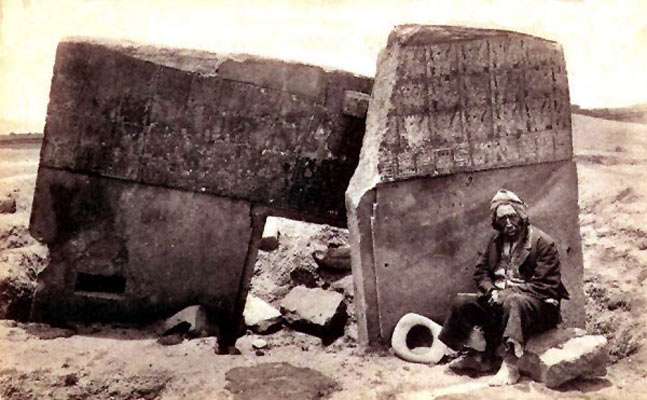
The Sun Gate at Tiahuanaco, or Tiwanaku, first discovered in the mid 19th century, the picture here dates from the beginning of the 20th century. The massive slab of stone was broken in two.
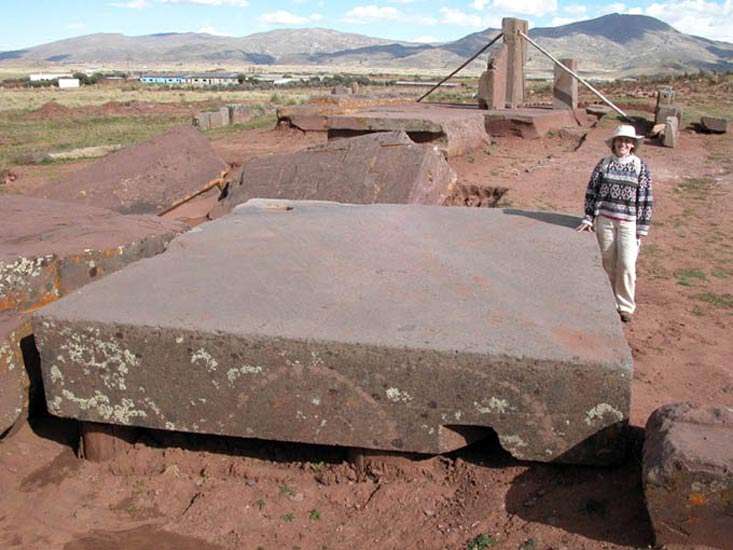
|
Just one of the many multi-ton blocks of very hard stone at Puma Punku, perfectly level, and right angled. Many of the stones have intricate cut-outs, and some have perfect cylindrical holes drilled in them. A nice example video about all this can be found on YouTube here, and here. |
|
After the cataclysm, Tiwanaku became the center of another culture that erected the Kalasasaya, which is a large courtyard of stones, erected as a new calendar, after the Earth has settled into a new sun cycle of 365 years, with the new Moon. You can find of an explanation of this new (our present) calendar built into the Kalasasaya at the website of Atlantis/Bolivia. |
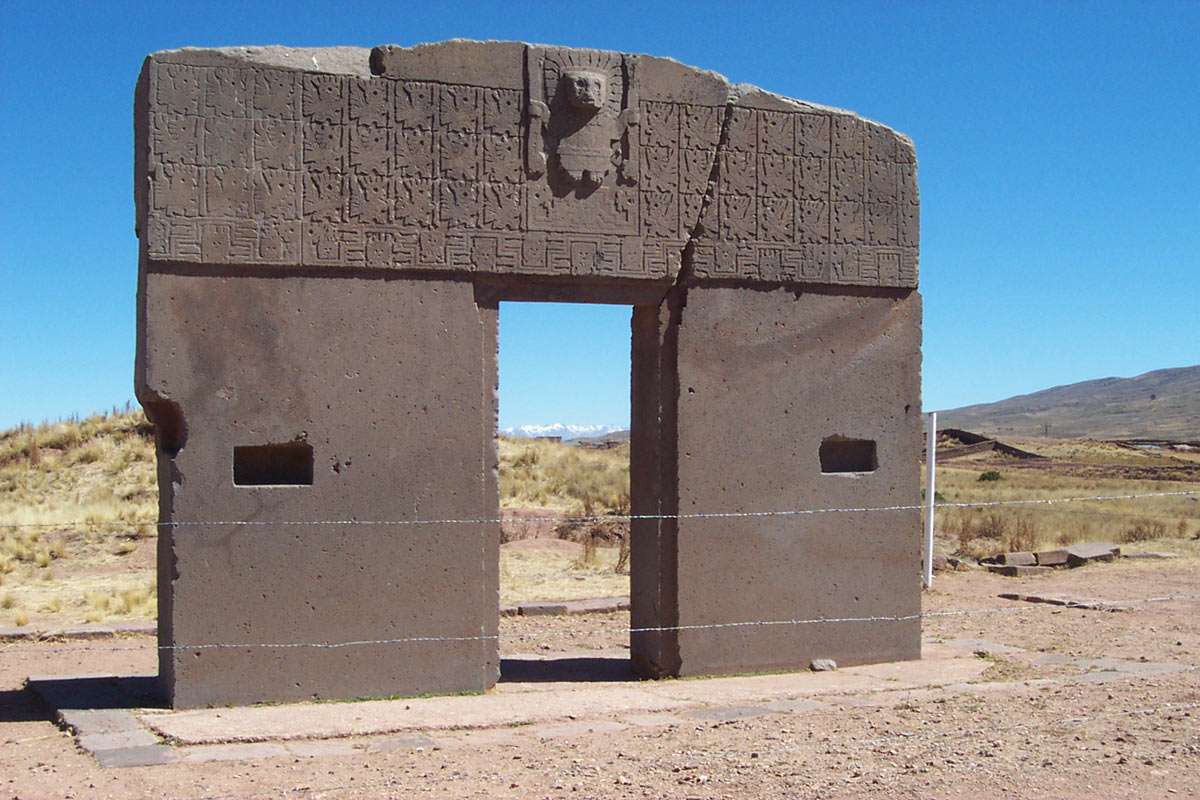
|
This is the Gate of the Sun today, dug out of the rubble and standing erect again. Some think that it might have been part of wall. |
|
When we pause for a second and look at the totality of the stone block, we find that it is approximately 9.8 feet (3.0 m) tall and 13 feet (4.0 m) wide, and is constructed from a single piece of stone, about ten tons in weight! It is a telltale example of the ancient (Atlantean) cultures who worked in multi-ton stone blocks, with perfect level surfaces and right angles as is the case with the Sun Gate too. These builders had no problems creating, and moving these stones, often over many miles distance and sometimes uphill. Someone made a remark that the Gate of the Sun seems to have been made out of cement, meaning that the entire structure was cemented into a previously constructed form. In the last couple of years this idea has been brought forward by several people who have studied the stones from the ancient megalithic builders, in different parts of the world. The stones from the Great Pyramid in Giza, for example are showing signs of having been cemented into forms. The same has been said of the Bosnian pyramids. The latest suggestion that has been made in this regard is that certain megalithic blocks were artificially created by a process similar to making cement. It is called geopolymer cement. Basically it is the mixing together of minerals (or certain pulverized rocks) in an alkaline or acidic medium. A chemical reaction ensues that results in the hardening of the mixture, creating a substance that is hard and durable as a rock itself. The advantage is manifold. One can make any mold to pour the mixture in, and the blocks are extremely hard and long lasting. The sides of the blocks are perfectly level and smooth, no chiseling or polishing required. One can also make very large and voluminous blocks. The Sun Gate is believed to be made out of andesite granite, a hard stone not easily worked by primitive copper or stone tools. The geopolymer technique seems to be a much more plausible explanation. But let us have a look at the images on the Sun Gate. |
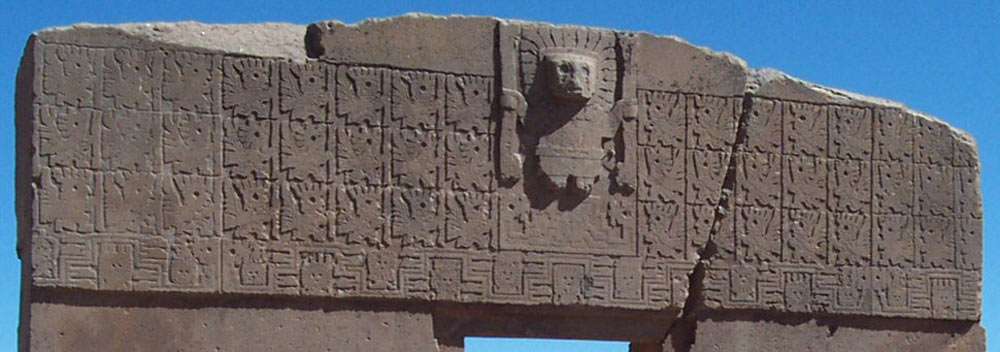
|
The top portion contains the hieroglyphs, which are all symbolic for parts of the calendar. The lintel is carved with 48 squares surrounding a central figure. Each square represents a character in the form of winged effigy. There are 32 effigies with human faces and 16 with condor's heads. All look to the central figure which some identify with the sun god. This figure's head is surrounded by 24 linear rays. He holds two styled staffs. |
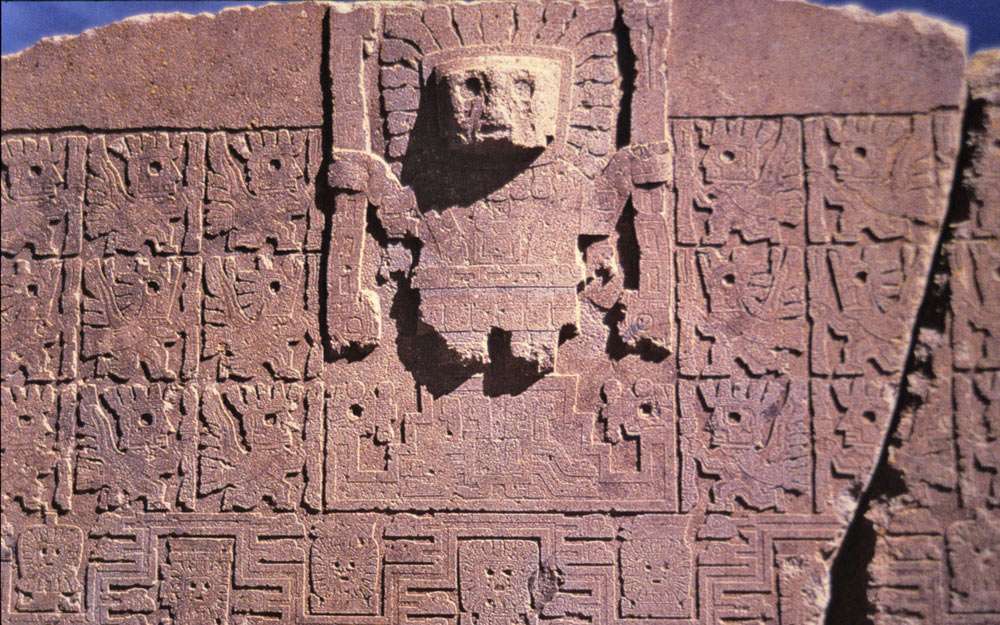
|
Central figure with characters left and right, and a bottom row with images. It does not look very interesting when looking at it because of the erosion. However when the entire calendar has been converted to its original state, many details show up, and it becomes a well organized display of astronomical knowledge. Every symbol and the sequence of symbols are important. |
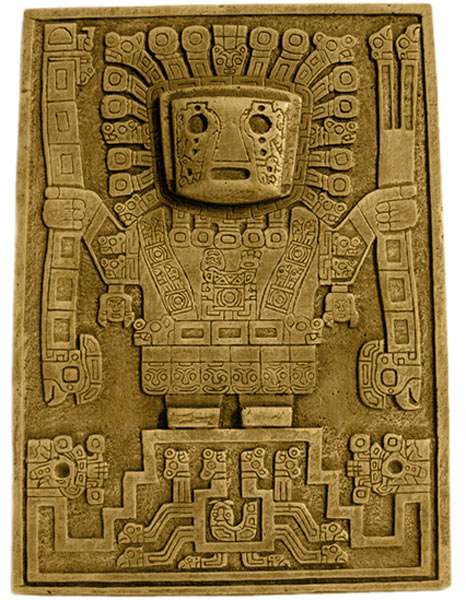
Reproduction of the central figure, making the details more pronounced.
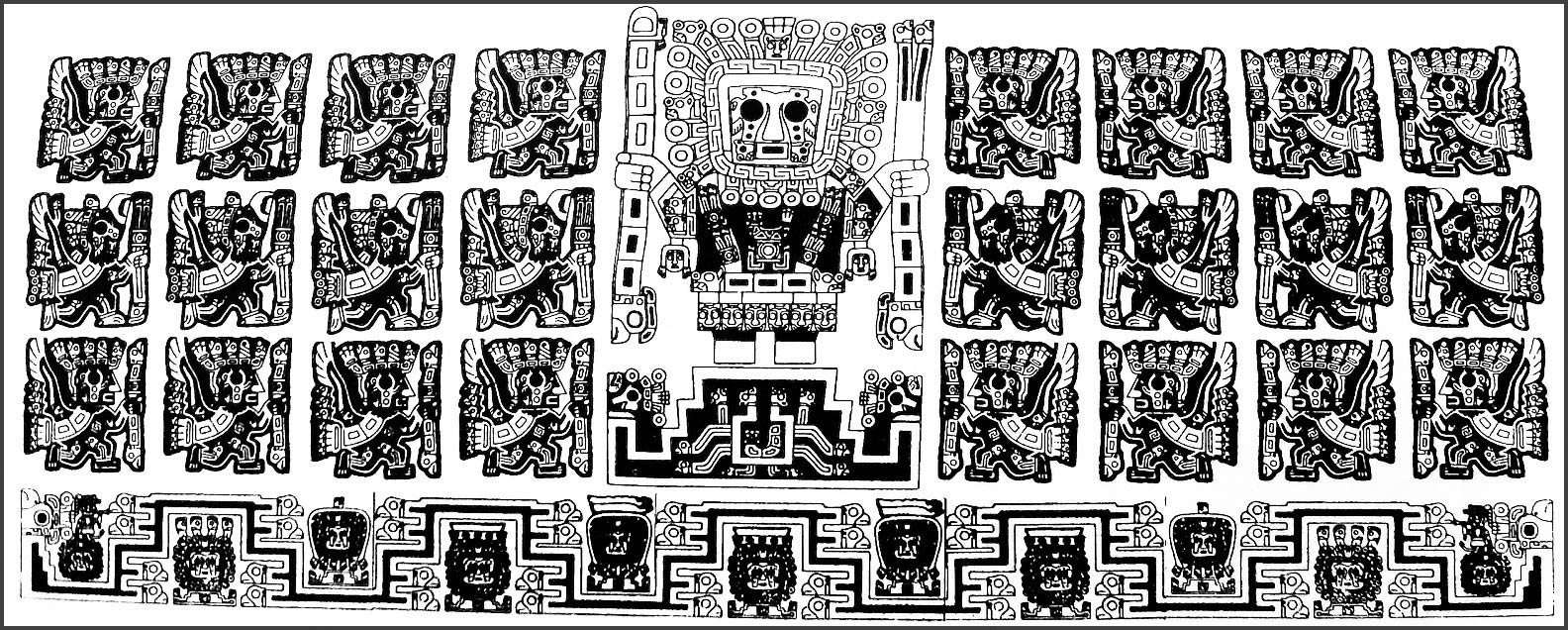
Drawing of the entire calendar. Every single detail has a meaning, including its position in the overall pattern.
|
I read the entire 400 pages of the Calendar of Teotihuacan, in which Dr. Bellamy explains every symbol, why this symbol was chosen for what it represents, its position in the overall calendar, and how the sun and the then existing moon moved throughout the year. What he found was that the Gate of the Sun is a unique depository of astronomical, mathematical, and scientific data, put down in a language that was very different from ours. The ancients did not have a written language as we do nowadays. They worked with hieroglyphs, symbols, which had minute details, and positioned them in an overall schematics and a directional flow of reading, that would allow to compress a lot of information into a small space. Dr. Bellamy meticulously analyzed the hieroglyphs, and discovered that they translated into a calendar, and other astronomical data. I went through the book in all its details, because I wanted to understand how the calendar worked. I am sure that all those 'scientists' who rejected the idea that the Sun Gate is a calendar, never bothered to read the entire book, nor did they understand how it was constructed. Once one understands the symbols and their positions, the entire Sun Gate, in all its details, is a well functioning calendar. I have no doubt that Dr. Bellamy understood how it worked and how it was originally created. I think the reason why most scientists choose to 'forget' his work, lies in the fact that the Sun Gate calendar does not reflect our present day calendar. It is a calendar of the Earth with another moon, at a time at least twelve thousand years ago, before great cataclysms changed the Earth rotation period and also its orbital angle. This was a time period, that is usually called the Atlantean period, when a highly advanced civilization had spread across the globe, erecting sophisticated cities and large buildings and other constructions out of multi-ton stone blocks fashioned by technology that was advanced but different from what we have today. These cataclysms were tremendous, causing major floods and tsunamis all over the Earth, destroying all the coastal cities. Many of them are now underwater, some have been found in recent decades, like Yonaguni in Japan. There were also major earthquakes, and major reshaping of the surface of the Earth. Teotihuacan was only one of these ancient cities. From recent excavations, we now that it was once a costal city, as ruins of its sea port have been found nearby. A major tsunami must have leveled all of it, as evidenced in nearby Puma Punku. The Puma Punku buildings were made of immense large multi-ton stone blocks that are now scattered around. It was originally thought that earthquakes were the reason for this, but building blocks have also been found buried under several feet of dirt, in one direction away from the original site, suggestion a forceful tsunami, that not only destroyed the entire area of Tiahuanaco but covered it with silt up to six feet deep. How is it possible that a city once being a sea port, is now at 30,000 feet (3,850 meters) high? The answer lies in the sudden rise of the land. In other words, the Andes mountains are the result of an immense rising of the land during those cataclysms. What could have been the reason for not only world wide immense geophysical changes, but also for a change in the rotation period and angle of the Earth? One thing is for certain. In the time period of Atlantis, we did not have our present Moon. There was a much smaller moon orbiting around the Earth as is evidenced the Sun Gate calendar. Our present day Moon arrived about twelve thousand years ago. That alone would have had a great impact on Earth because of gravitational forces. The Moon cannot be a natural moon of the Earth because it is too big for the size of planet Earth. It can only be a moon of a much larger planet like Saturn, Jupiter or Neptune. The Moon is actually a small planetoid. How it ended up in an orbit around Earth is a question of debate. It might have happened when the former fifth planet exploded, and created havoc in the solar system, upsetting almost all the other planets, drastically changing their axial tilts, their magnetic fields, their orbits around the sun and so on. So the Moon might have been hurled away and it ended up around Earth. However there are too many signs that the Moon, wherever it came from, was placed around the Earth in a carefully planned orbit. The reason for this are features that are very exceptional in a natural formation of a solar system. The Moon rotation around the Earth is the same as its rotation around its own axis, thus always facing the same side towards the Earth. The distance from the Earth causes sun eclipses, where the diameter of the Moon is exactly the same as the diameter of the sun, as seen from the Earth. It is my own opinion that the Moon was placed here by extraterrestrials for the purpose of destroying the world wide civilization that was present on Earth, and to keep humanity under energetic and psychological control from their bases on and inside the Moon. That is a topic that I cannot go into here, I have written about it in my other articles. I should also mention that indigenous cultures around the planet have legends that state that our Moon is a late arrival, and that the ancient people were living in a time period when the Moon was not present. Let's go back to the calendar. |
|
As I mentioned before, the solar year in Atlantean times was different. Earth revolved around the sun more quickly, and a year was 290 days long. The solar year was divided in twelve periods (or months) of 24 days, plus 2 extra days. (12 X 24)+2=290 days. As a side note: it is interesting that Tom Van Flandern, of the www.metaresearch.org, who proposed that at least one planet (where now the asteroid belt is) exploded in our solar system, based on the data we have from all the planets and moons, gives the previous orbit of Earth around the Sun as 0.8 times the present distance. In other words, Earth used to be closer to the Sun and thus probably had s shorter solar year. He doesn't give any dates for when this planet exploded, but I think it happened as recent as twelve thousand years ago, when the Atlantean civilization came to an end in global catastrophes, resulting in tremendous earthquakes, floodings and even the rising of the Andes mountains. The then present moon was much smaller and much closer to the Earth. Bellamy calculated it being at 60,000 miles (97,000 km), center to center; our present moon being at 240,000 miles (384,000 km). It moved around the Earth much more quickly, and rose in the West and set in the East. It caused a great number of solar eclipses. Of course it caused an equal number of moon eclipses. Different symbols show when these solar eclipses, occurred, even when it happened during the day: at sunrise, at noon, at sunset. The calendar also gives the beginning of the year, the days of the equinoxes and solstices, the incidence of the two intercalary days, information on the obliquity of the ecliptic (then about 16.5 degrees; now 23.5) and on Tiahuanaco's latitude (then about 10 degrees; now 16.27), and many other astronomical and geographical references from which interesting and important data may be calculated. The also divided the circle in 264 degrees, in contrast with our present day 360 degrees. The following is just a quick overview how the calendar works, to give you an idea how astronomical information can be encoded and read easily in a compact, but detailed hieroglyphic schematic. |
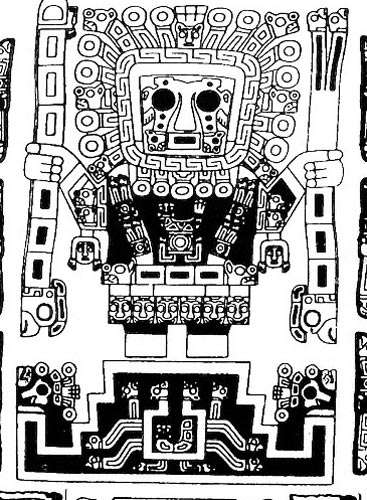
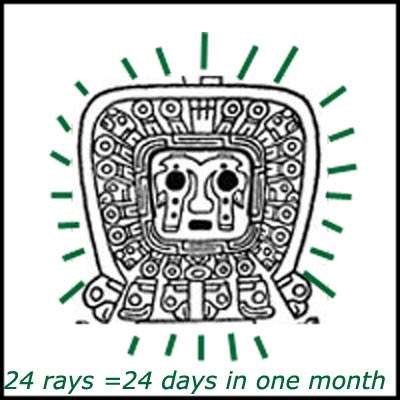
|
The Central figure represents the first month of the solar year which starts at the Spring Equinox. It also doubles as the last month of the calendar as you will see below. The head of the central figure (and all the heads in the underlying meander line) represents the days of the month. Each head (month) has 24 rays (days). So we first follow the 24 days throughout the month. Each jaguar head is a solar eclipse (the jaguar is a night animal, hence the symbol of eclipses), when the little moon passes in front of the sun. At the end of the first month, we have to go down to the meander line underneath, the his staff shows. The condor head at the bottom of the staff shows the direction of reading. |
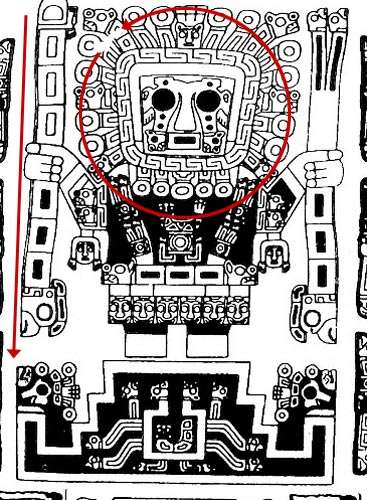

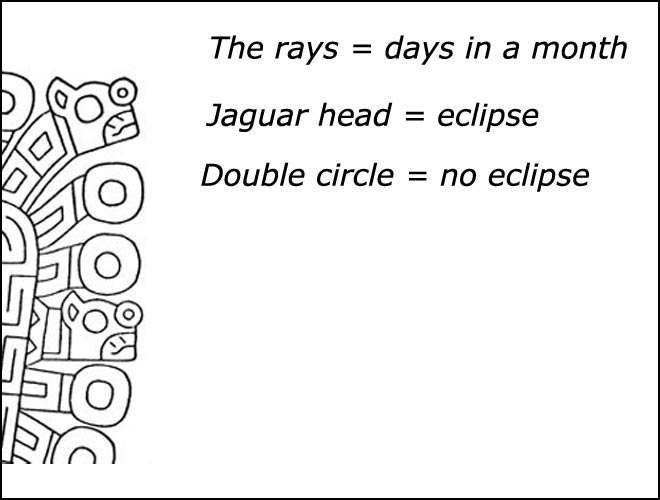
|
Then we enter the meander line underneath, and follow the months (every meander is a month) to the left until we arrive at the end of the row which is the month of the summer solstice. Here we find a little figure blowing a trumpet facing right. This means we now travel back, to the right, continuing through the months, arriving back at the middle which is now the fall equinox. We continue to go right, until we arrive at the winter solstice at the right, far end of the meander line. Another little figure blows his trumpet facing the left. We turn around and go left until we arrive back at the spring equinox in the middle but above the meander line. |
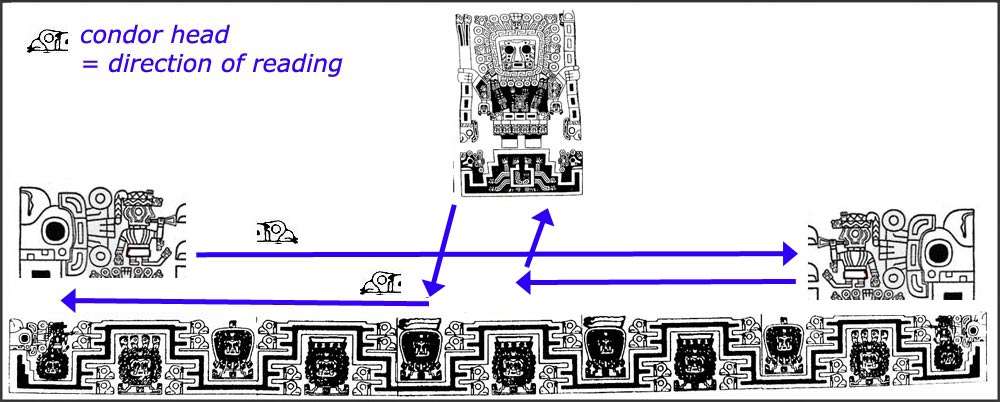
|
Upon arriving at the left and right end of the meander line, the little figure with trumpet tells us to go back : |
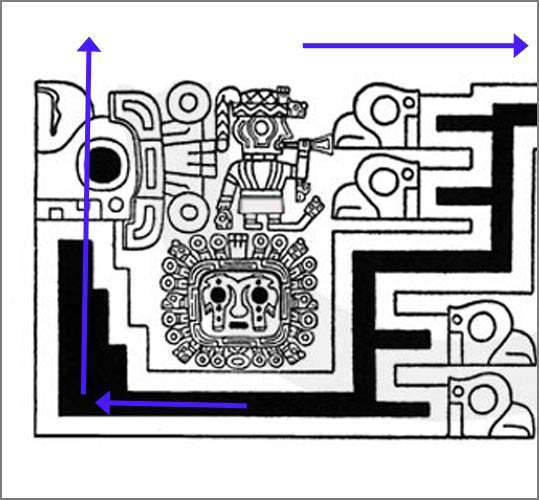
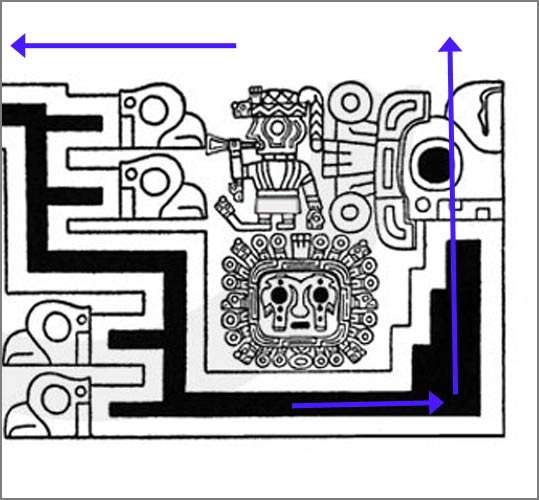
|
Each head, of the central figure and inside the meander line, represents two months, as we go left and right and up again. |
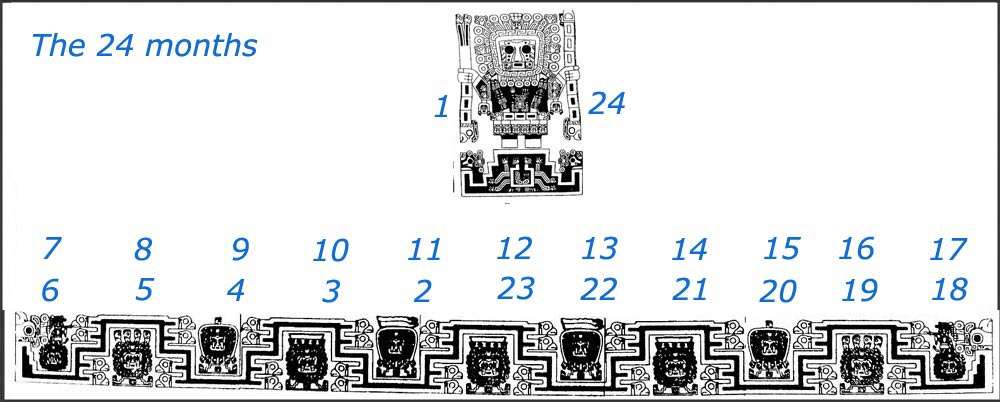
|
The equinoxes and solstices are situated at the ends of the meander line, and in the middle of the display. |
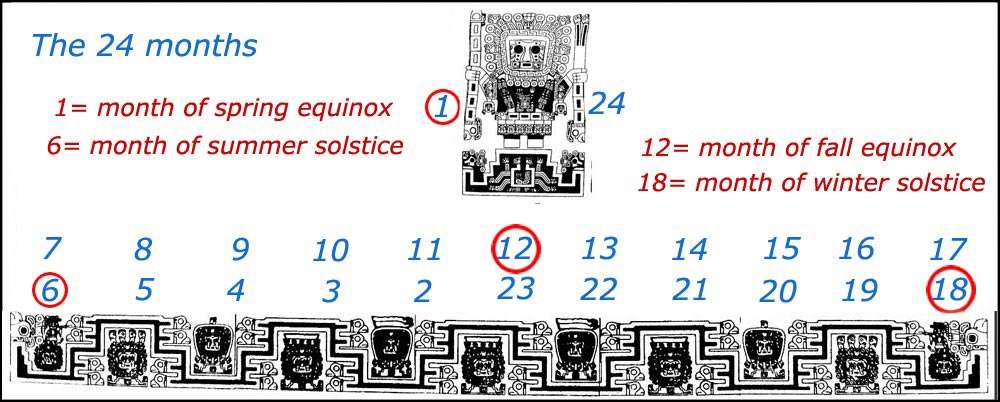
|
What the Sun Gate Calendar shows is that the ancients had a way to write down complex information in a compact iconographic form, in which every detail had a meaning. It is a entirely different form of writing than we have with our letters, words, and sentences. Their way of writing was very structural, mathematical, and directional. What the Sun Gate Calendar also shows is that the world of people before the catastrophes of 12,000 years ago must have been quite different. A much smaller moon would have meant that there were no or almost no tides of the oceans, seas, bays, rivers. A lesser axial tilt of the Earth would have resulted in less pronounced seasons. A quicker rotation of the earth around the Sun, with a smaller year of 290 days, would also have had its influence on growth cycles of plants and animals. The menstrual cycles of women, which at present is tied in with our present Moon, would also have been different. |